Micro Analysis of The Coca-Cola Company
VerifiedAdded on 2023/06/10
|5
|960
|428
AI Summary
This paper carries out a micro analysis of The Coca-Cola Company, evaluating its microenvironment, customers, competitors, and the company itself.
Contribute Materials
Your contribution can guide someone’s learning journey. Share your
documents today.
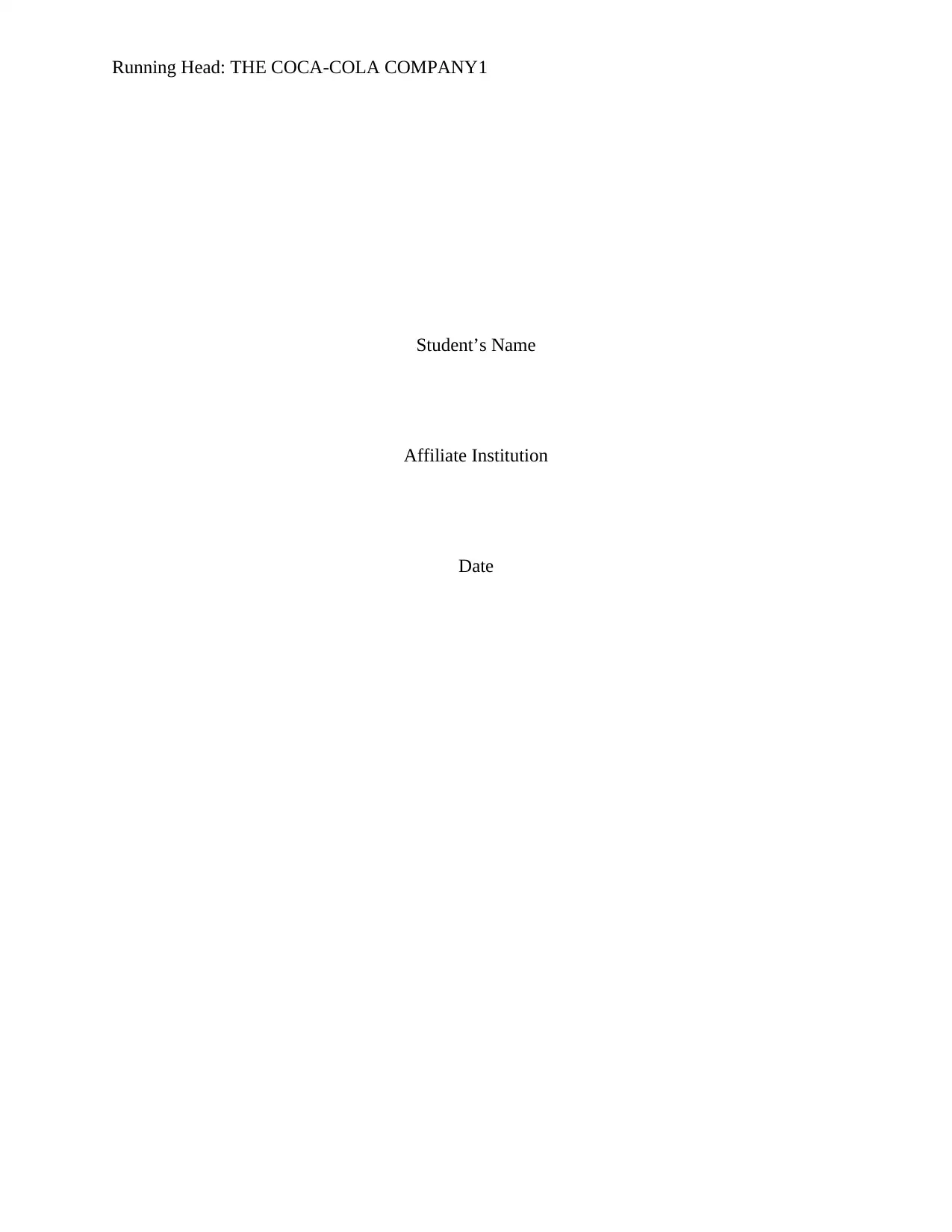
Running Head: THE COCA-COLA COMPANY1
Student’s Name
Affiliate Institution
Date
Student’s Name
Affiliate Institution
Date
Secure Best Marks with AI Grader
Need help grading? Try our AI Grader for instant feedback on your assignments.
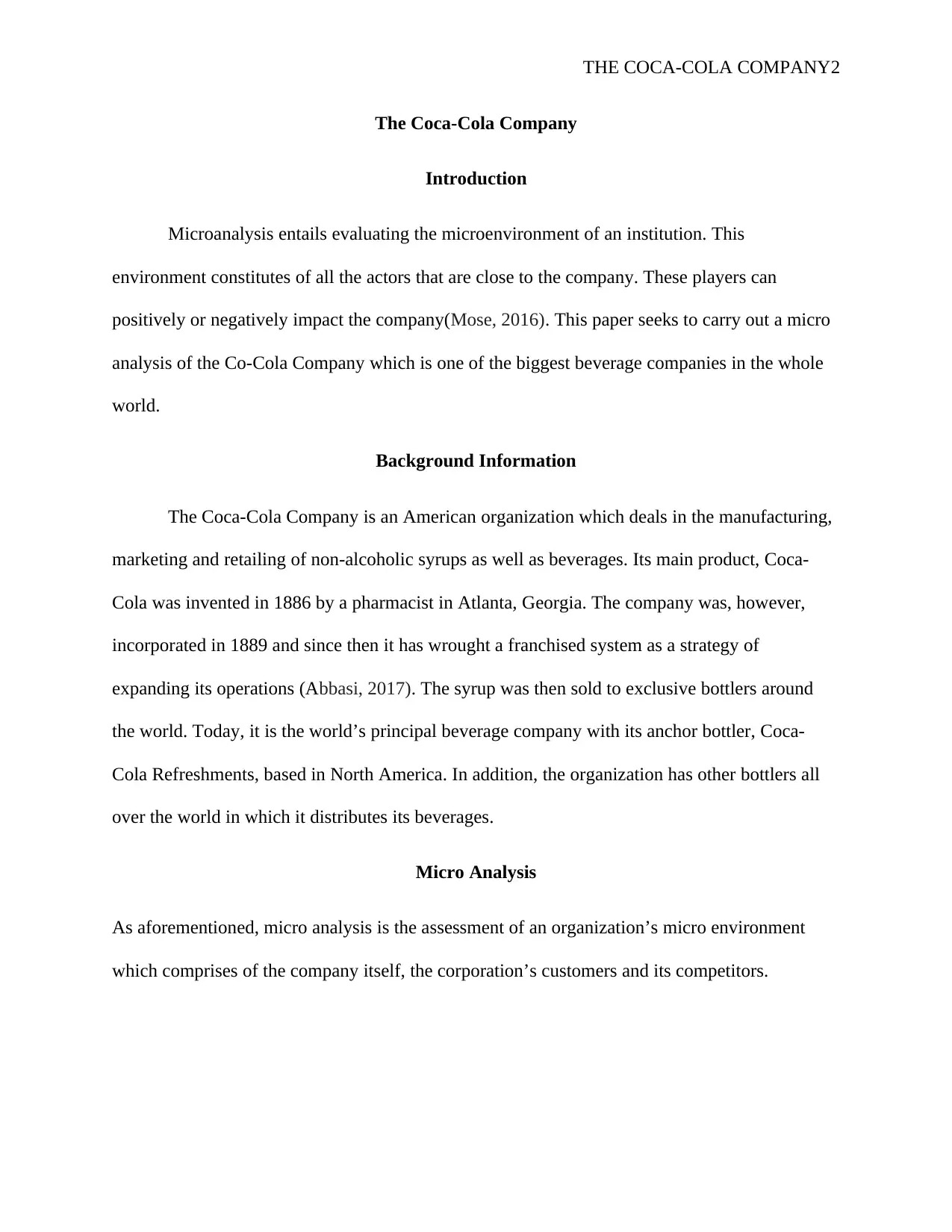
THE COCA-COLA COMPANY2
The Coca-Cola Company
Introduction
Microanalysis entails evaluating the microenvironment of an institution. This
environment constitutes of all the actors that are close to the company. These players can
positively or negatively impact the company(Mose, 2016). This paper seeks to carry out a micro
analysis of the Co-Cola Company which is one of the biggest beverage companies in the whole
world.
Background Information
The Coca-Cola Company is an American organization which deals in the manufacturing,
marketing and retailing of non-alcoholic syrups as well as beverages. Its main product, Coca-
Cola was invented in 1886 by a pharmacist in Atlanta, Georgia. The company was, however,
incorporated in 1889 and since then it has wrought a franchised system as a strategy of
expanding its operations (Abbasi, 2017). The syrup was then sold to exclusive bottlers around
the world. Today, it is the world’s principal beverage company with its anchor bottler, Coca-
Cola Refreshments, based in North America. In addition, the organization has other bottlers all
over the world in which it distributes its beverages.
Micro Analysis
As aforementioned, micro analysis is the assessment of an organization’s micro environment
which comprises of the company itself, the corporation’s customers and its competitors.
The Coca-Cola Company
Introduction
Microanalysis entails evaluating the microenvironment of an institution. This
environment constitutes of all the actors that are close to the company. These players can
positively or negatively impact the company(Mose, 2016). This paper seeks to carry out a micro
analysis of the Co-Cola Company which is one of the biggest beverage companies in the whole
world.
Background Information
The Coca-Cola Company is an American organization which deals in the manufacturing,
marketing and retailing of non-alcoholic syrups as well as beverages. Its main product, Coca-
Cola was invented in 1886 by a pharmacist in Atlanta, Georgia. The company was, however,
incorporated in 1889 and since then it has wrought a franchised system as a strategy of
expanding its operations (Abbasi, 2017). The syrup was then sold to exclusive bottlers around
the world. Today, it is the world’s principal beverage company with its anchor bottler, Coca-
Cola Refreshments, based in North America. In addition, the organization has other bottlers all
over the world in which it distributes its beverages.
Micro Analysis
As aforementioned, micro analysis is the assessment of an organization’s micro environment
which comprises of the company itself, the corporation’s customers and its competitors.
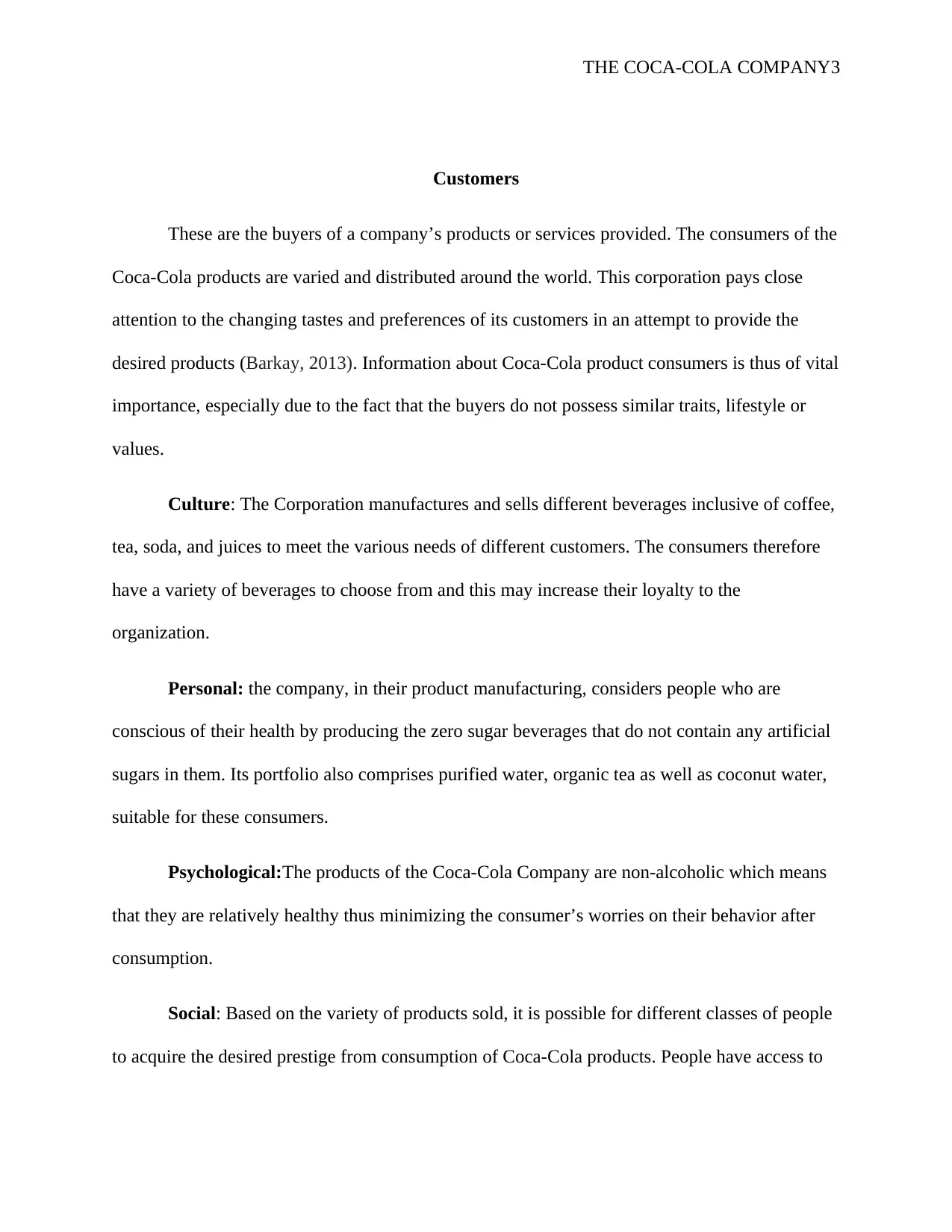
THE COCA-COLA COMPANY3
Customers
These are the buyers of a company’s products or services provided. The consumers of the
Coca-Cola products are varied and distributed around the world. This corporation pays close
attention to the changing tastes and preferences of its customers in an attempt to provide the
desired products (Barkay, 2013). Information about Coca-Cola product consumers is thus of vital
importance, especially due to the fact that the buyers do not possess similar traits, lifestyle or
values.
Culture: The Corporation manufactures and sells different beverages inclusive of coffee,
tea, soda, and juices to meet the various needs of different customers. The consumers therefore
have a variety of beverages to choose from and this may increase their loyalty to the
organization.
Personal: the company, in their product manufacturing, considers people who are
conscious of their health by producing the zero sugar beverages that do not contain any artificial
sugars in them. Its portfolio also comprises purified water, organic tea as well as coconut water,
suitable for these consumers.
Psychological:The products of the Coca-Cola Company are non-alcoholic which means
that they are relatively healthy thus minimizing the consumer’s worries on their behavior after
consumption.
Social: Based on the variety of products sold, it is possible for different classes of people
to acquire the desired prestige from consumption of Coca-Cola products. People have access to
Customers
These are the buyers of a company’s products or services provided. The consumers of the
Coca-Cola products are varied and distributed around the world. This corporation pays close
attention to the changing tastes and preferences of its customers in an attempt to provide the
desired products (Barkay, 2013). Information about Coca-Cola product consumers is thus of vital
importance, especially due to the fact that the buyers do not possess similar traits, lifestyle or
values.
Culture: The Corporation manufactures and sells different beverages inclusive of coffee,
tea, soda, and juices to meet the various needs of different customers. The consumers therefore
have a variety of beverages to choose from and this may increase their loyalty to the
organization.
Personal: the company, in their product manufacturing, considers people who are
conscious of their health by producing the zero sugar beverages that do not contain any artificial
sugars in them. Its portfolio also comprises purified water, organic tea as well as coconut water,
suitable for these consumers.
Psychological:The products of the Coca-Cola Company are non-alcoholic which means
that they are relatively healthy thus minimizing the consumer’s worries on their behavior after
consumption.
Social: Based on the variety of products sold, it is possible for different classes of people
to acquire the desired prestige from consumption of Coca-Cola products. People have access to
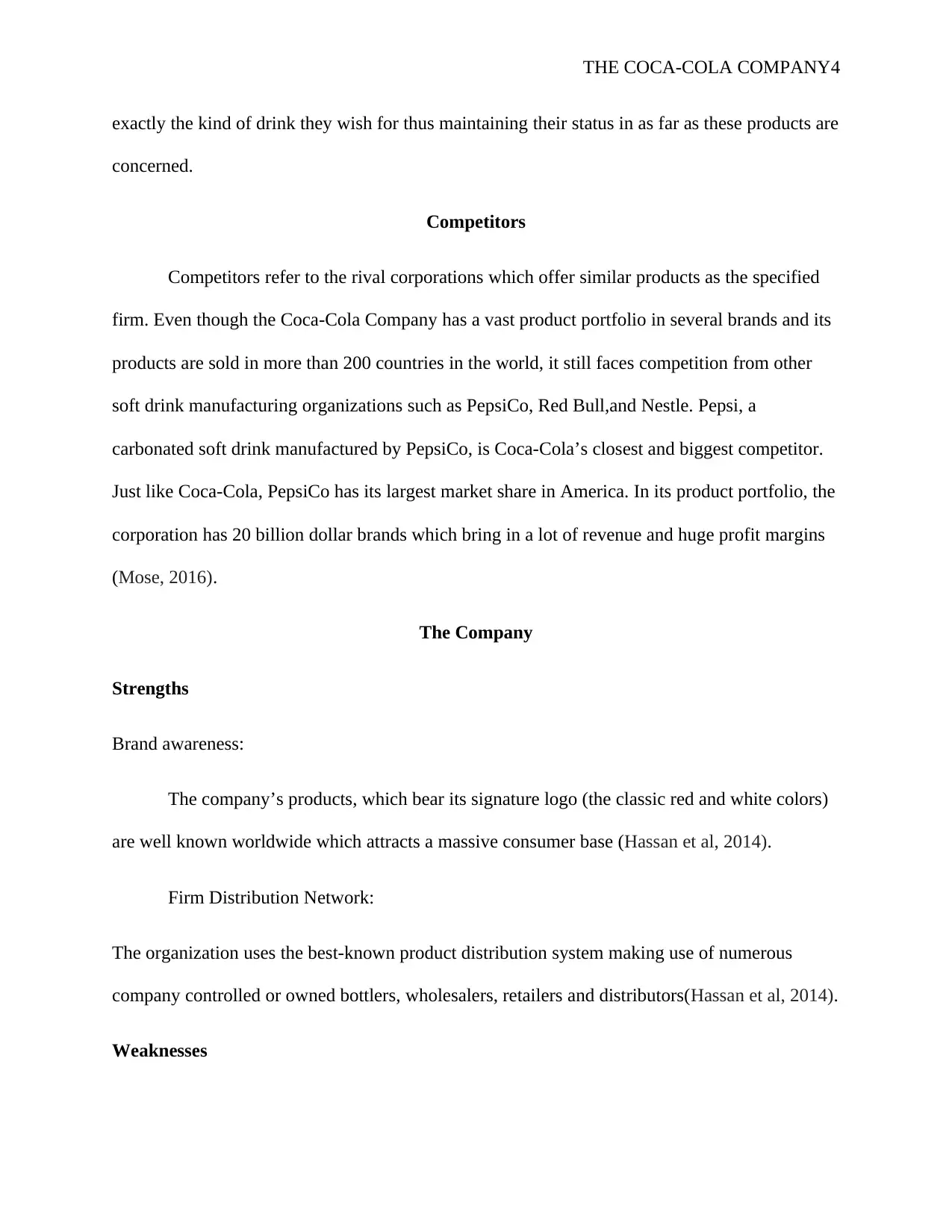
THE COCA-COLA COMPANY4
exactly the kind of drink they wish for thus maintaining their status in as far as these products are
concerned.
Competitors
Competitors refer to the rival corporations which offer similar products as the specified
firm. Even though the Coca-Cola Company has a vast product portfolio in several brands and its
products are sold in more than 200 countries in the world, it still faces competition from other
soft drink manufacturing organizations such as PepsiCo, Red Bull,and Nestle. Pepsi, a
carbonated soft drink manufactured by PepsiCo, is Coca-Cola’s closest and biggest competitor.
Just like Coca-Cola, PepsiCo has its largest market share in America. In its product portfolio, the
corporation has 20 billion dollar brands which bring in a lot of revenue and huge profit margins
(Mose, 2016).
The Company
Strengths
Brand awareness:
The company’s products, which bear its signature logo (the classic red and white colors)
are well known worldwide which attracts a massive consumer base (Hassan et al, 2014).
Firm Distribution Network:
The organization uses the best-known product distribution system making use of numerous
company controlled or owned bottlers, wholesalers, retailers and distributors(Hassan et al, 2014).
Weaknesses
exactly the kind of drink they wish for thus maintaining their status in as far as these products are
concerned.
Competitors
Competitors refer to the rival corporations which offer similar products as the specified
firm. Even though the Coca-Cola Company has a vast product portfolio in several brands and its
products are sold in more than 200 countries in the world, it still faces competition from other
soft drink manufacturing organizations such as PepsiCo, Red Bull,and Nestle. Pepsi, a
carbonated soft drink manufactured by PepsiCo, is Coca-Cola’s closest and biggest competitor.
Just like Coca-Cola, PepsiCo has its largest market share in America. In its product portfolio, the
corporation has 20 billion dollar brands which bring in a lot of revenue and huge profit margins
(Mose, 2016).
The Company
Strengths
Brand awareness:
The company’s products, which bear its signature logo (the classic red and white colors)
are well known worldwide which attracts a massive consumer base (Hassan et al, 2014).
Firm Distribution Network:
The organization uses the best-known product distribution system making use of numerous
company controlled or owned bottlers, wholesalers, retailers and distributors(Hassan et al, 2014).
Weaknesses
Secure Best Marks with AI Grader
Need help grading? Try our AI Grader for instant feedback on your assignments.
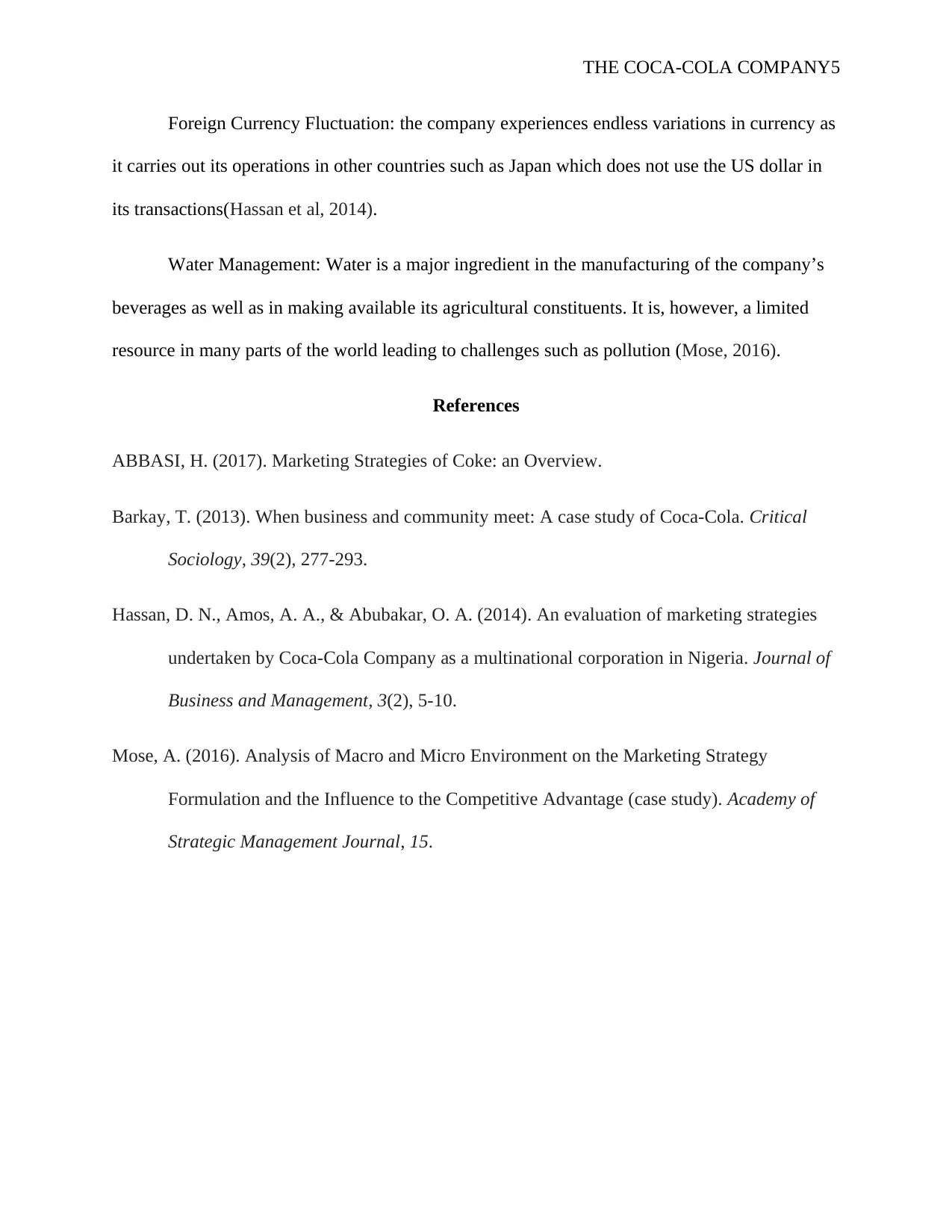
THE COCA-COLA COMPANY5
Foreign Currency Fluctuation: the company experiences endless variations in currency as
it carries out its operations in other countries such as Japan which does not use the US dollar in
its transactions(Hassan et al, 2014).
Water Management: Water is a major ingredient in the manufacturing of the company’s
beverages as well as in making available its agricultural constituents. It is, however, a limited
resource in many parts of the world leading to challenges such as pollution (Mose, 2016).
References
ABBASI, H. (2017). Marketing Strategies of Coke: an Overview.
Barkay, T. (2013). When business and community meet: A case study of Coca-Cola. Critical
Sociology, 39(2), 277-293.
Hassan, D. N., Amos, A. A., & Abubakar, O. A. (2014). An evaluation of marketing strategies
undertaken by Coca-Cola Company as a multinational corporation in Nigeria. Journal of
Business and Management, 3(2), 5-10.
Mose, A. (2016). Analysis of Macro and Micro Environment on the Marketing Strategy
Formulation and the Influence to the Competitive Advantage (case study). Academy of
Strategic Management Journal, 15.
Foreign Currency Fluctuation: the company experiences endless variations in currency as
it carries out its operations in other countries such as Japan which does not use the US dollar in
its transactions(Hassan et al, 2014).
Water Management: Water is a major ingredient in the manufacturing of the company’s
beverages as well as in making available its agricultural constituents. It is, however, a limited
resource in many parts of the world leading to challenges such as pollution (Mose, 2016).
References
ABBASI, H. (2017). Marketing Strategies of Coke: an Overview.
Barkay, T. (2013). When business and community meet: A case study of Coca-Cola. Critical
Sociology, 39(2), 277-293.
Hassan, D. N., Amos, A. A., & Abubakar, O. A. (2014). An evaluation of marketing strategies
undertaken by Coca-Cola Company as a multinational corporation in Nigeria. Journal of
Business and Management, 3(2), 5-10.
Mose, A. (2016). Analysis of Macro and Micro Environment on the Marketing Strategy
Formulation and the Influence to the Competitive Advantage (case study). Academy of
Strategic Management Journal, 15.
1 out of 5
Related Documents
Your All-in-One AI-Powered Toolkit for Academic Success.
+13062052269
info@desklib.com
Available 24*7 on WhatsApp / Email
![[object Object]](/_next/static/media/star-bottom.7253800d.svg)
Unlock your academic potential
© 2024 | Zucol Services PVT LTD | All rights reserved.





